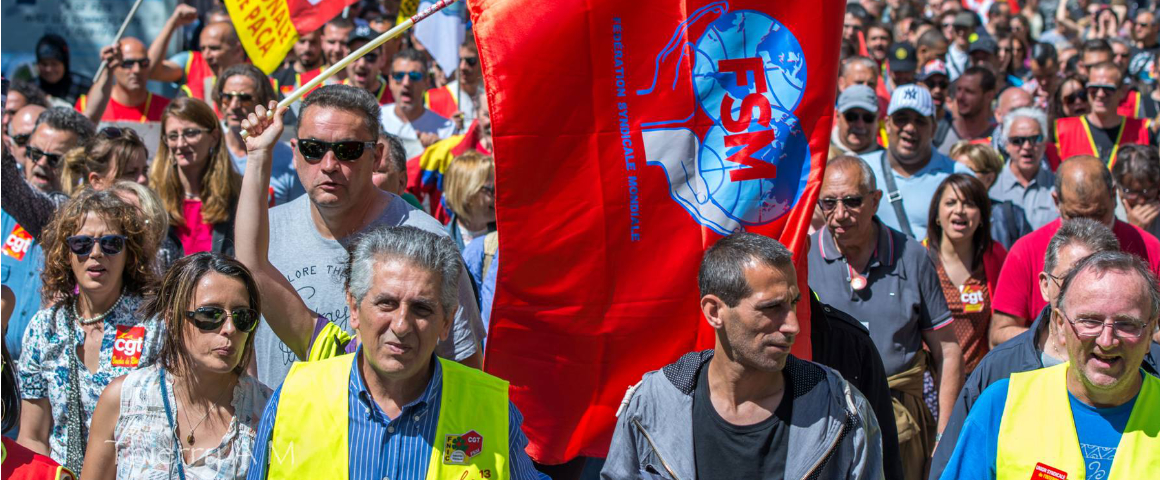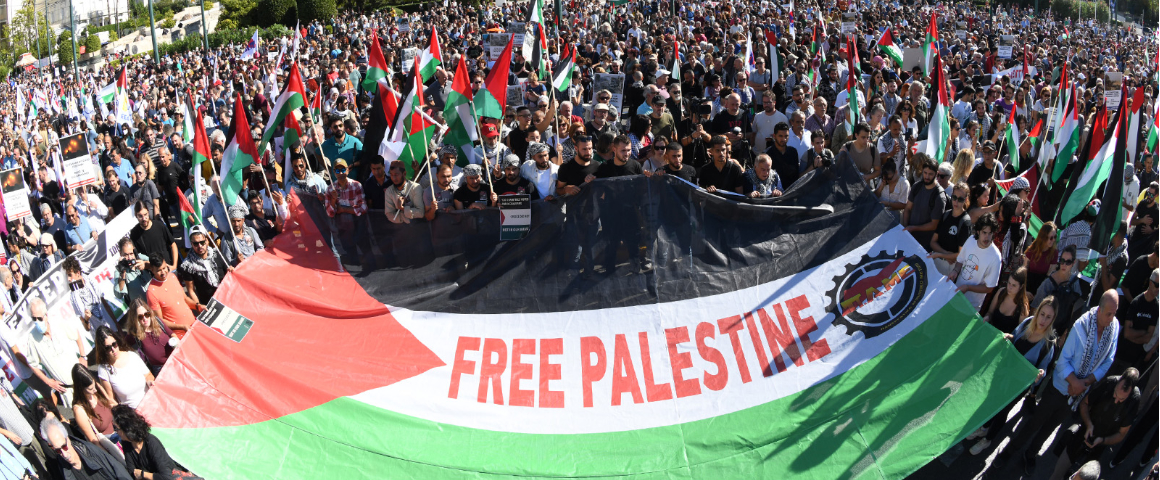Critical Notes on the History of the World Trade Union Movement: Issues of Tactics and Strategy
George Mavrikos (Translated from Greek by Maria Barouti)
International Workers’ Institute, Athens, 2023
Review by Joseph Jamison
The author of this impressive book Critical Notes on the History of the World Trade Union Movement, George Mavrikos, spent twenty-two years as vice president and then general secretary of the World Federation of Trade Unions (WFTU).
Coming out of the left wing of the Greek trade unions, in the course of his work for WFTU Mavrikos traveled to 87 countries and has been at the centre of the global labour movement. The book sums up the lessons and conclusions of his life’s work, dedicated to the ideal expressed in the famous watchword at the conclusion of the Communist Manifesto: “Workers of the World Unite!”
If there is one overarching political theme in Critical Notes it is the struggle against class collaboration in the union movement. In a speech to South African trade unions in 2012 called “Two Lines in Constant Contradistinction,” Mavrikos declared:
“It is easy even for the ordinary reader of trade union history to realize that already since the infancy of trade union organizations, from the appearance and concentration of the young working class, the contradistinctions ultimately led to the crucial issue: What line will the trade union follow? Will it be a class line or not? Depending on the majority current of the period and the organization, one or the other line was imprinted in its constitution: Line-orientation: Struggle or Compromise?”
As far back as February 1945, as the founding WFTU Congress was being prepared in London, two political groupings could be detected.
Two lines and two groups of forces appeared at the London Conference when discussions began on the need to establish a new world trade union organization that would bring together in its ranks all the unions from around the world. The first group consisted of conservatives, social democrats, other bureaucrats and reformists, led by the unions of Great Britain, the US, the Netherlands and some other Europeans. The second group was the one of the communists, democrats and progressive trade unionists who allied with the communists under these circumstances. This group was led by the Soviet trade unions, the All-China Federation of Unions and India. The unions of Latin America, France, Italy, Greece, Bulgaria, Australia, etc. were aligned with them.
Mavrikos begins Critical Notes by sketching the main periods of global trade union history. The first sixty pages of the volume centre on the earliest history of the union movement: the formation of the working class, the foundation of the first trade unions and the birth of the First International (International Workingmen’s Association, 1864-1872) in which Marx and Engels themselves were among the main leaders. The First International was primarily a political organization but it supported strikes, helped to found national central unions and campaigned against child labour and discrimination against women.
In the last decades of the 19th century the working class and trade unionism expanded dramatically in Western and Central Europe with left and right trends vying. The Second International flourished from 1886 to 1914, before it collapsed ignominiously when the First World War broke out. In 1905 came the first stirrings of revolution in Russia.
George Mavrikos was born in 1950 in Greece, on the Aegean Island of Skyros, into a family of shepherds. He emigrated to Athens, attending night technical school and holding down jobs in shipyards, the metals industry and textile industry. He was often fired for trade union and political activity. While working at Thessaloniki he studied law at the Aristotle University.
He began his political and union activity during the military dictatorship in Greece (1967-74). In 1976 he was elected president of the Athens Private Employees Union. He became general secretary of the General Confederation of Greek Workers, serving from 1993-1998. He led PAME (All-Workers Militant Front) from its beginning in1999 until 2007. In 2005-2012 he was an elected member of the Greek parliament for the Communist Party of Greece (KKE). He was vice president of WFTU from 2000-2005 and its secretary general from 2005 to 2022. When he retired in 2022, he was elected Honourary President of WFTU as a sign of gratitude for his lifetime contribution.
The main part of the book is Mavrikos’s account of the struggle to create and defend the new World Federation of Trade Unions. After the Second World War (1939-1945) an almost completely new architecture of international relations – including international trade union relations –came into being. The most important development was that, at the inter-state level, the United Nations replaced the moribund League of Nations (1920-45). Its leading body the Security Council was composed of five permanent members (US, Britain, USSR, China and France) who had fought against fascism in the world war.
Before 1945, two international trade union organizations had dominated the scene. On the right, the Amsterdam International was founded in 1919, composed of supporters of social reformism, opportunism and class partnership. It cooperated with the principal Western European governments and the US government.
On the left, the Red International of Labour Unions (RILU or Profintern, 1920-1937) was founded in 1920 at the initiative of the Communist International, which declared its main principle to be class struggle. Unions adhering to the RILU believed that trade unions must support the struggle for socialism as well as daily struggles for partial reforms, and they must oppose fascism and colonialism.
The World Federation of Trade Unions was born in Paris on October 3, 1945, when briefly a tenuous unity existed among the Big Three great powers (Britain, US, USSR) that had defeated fascism. But preparatory discussions in London from February 1945 onward showed how fragile that unity was. British unions, for example, wanted no discussion of colonialism. In the Paris founding Congress later that year, the American Federation of Labour (AFL) did not participate, unlike the Congress of Industrial Organizations (CIO, not yet having expelled its left-led unions) which did participate. The Catholic trade union centre, the International Confederation of Christian Trade Unions (ICCTU), claiming three million members, refused to join WFTU. On the other hand, the Amsterdam International dissolved itself in December 1945 and joined WFTU.
Splits were to follow as the Cold War grew frostier. In March 1947 came the Truman Doctrine, which provided US aid to reactionary regimes in Greece and Turkey. In June 1947 the US proposed the $12 billion Marshall Plan, an immense sum at the time, which was conditional on anti-communist actions by Western European governments. In April 1949 the NATO military alliance was formed. In December 1949 at the instigation of the AFL, the International Confederation of Free Trade Unions (ICFTU) was created.
Congresses are where the inner political life of international labour organizations is most visible. They are where debates are sharpest, where assessments of new trends are heard, where resolutions are adopted or rejected, and where policy decisions are made.
Much of Critical Notes consists of the author’s trenchant commentary on the global political context of successive WFTU Congresses, often in the form of excerpts from his speeches and letters. He singles out three of the most critical WFTU Congresses “that faced and resolved issues that had to do with the very existence of the WFTU”: the founding Congress in Paris in October 1945; the second Congress in Milan, Italy in July 1949; and the 13th Congress in November 1994 in Damascus, Syria in the aftermath of the downfall of socialism in Eastern Europe and the USSR.
At its founding Congress in Paris, two main ideological currents were vying within WFTU – the class collaborationist line and the class struggle line. In Paris, WFTU achieved only superficial organizational unity, but not real unity. Mavrikos writes, “For a class-oriented strategy a superior quality of unity was required.”
In 1949 in Milan, amid the deepening Cold War, the political context was the split in WFTU, with the right-wing unions, led by the AFL and the British Trades Union Congress (TUC) departing to form the ICFTU, to be headquartered in Brussels. In 2006, ICFTU was renamed ITUC (International Trade Union Confederation). To this day, its priorities are shared by the US State Department, and it works closely with multinationals and monopolies on a class partnership basis.
In 1994, after the downfall of socialism in Eastern Europe and the Soviet Union, “the world map changed, and the international balance of power leaned dramatically in favour of imperialism.” The pro-capitalist forces had momentum and WFTU did not escape their attack. The drive to dissolve WFTU was led by elements in the French Confédération générale du travail (CGT) and the Italian Confederazione Generale Italiana del Lavoro (CGIL). Only one country offered to host the Congress – Syria. The Syrian government of Hafez al-Assad agreed to organize and cover all the expenses of the Congress. At the Congress the Syrian, Cuban and Indian trade unions defeated all proposals for dissolution. WFTU survived.
Mavrikos believes contemporary reformism and class collaboration are updating their arguments. He spells out the “new” reformist arguments:
- “The working class is different today.”
- “The trade unions need to find new forms of struggle, more modern, more effective more attractive to the mass media.”
- “Solutions will come from ‘social dialogue and social partnership.’”
- “Union goals must be more realistic; unions must abandon ‘maximalist logic.’”
- “Union mobilizations and strikes yield little in terms of tangible rewards for workers.”
He then outlines point by point how WFTU is responding to this re-packaging of reformism. To take the first claim – the working class is different today – the working class does indeed have some new features, but it retains basic features that are timeless. The modern working class has accumulated experience of militant struggle, has a higher level of culture and education, and enjoys growing access to new technologies that enhance its role at the heart of the productive process.
A cornerstone of WFTU – unlike ICFTU/ITUC – has been its commitment to decolonization and opposition to imperialism and apartheid. This gives it great strength and prestige among working people and their trade unions in Asia, Africa and Latin America. The splits that took place in the early years were mainly in Western Europe and North America, where the material basis for reformism was stronger. Few defections have taken place in the Global South.
Mavrikos is unsparing in his denunciation of political corruption in ICFTU/ITUC), referring to its “co-operation with state secret services” and the “buying off and bribery of trade unions and trade unionists always with the aim of breaking the unity of the working class and its complete identification with social democracy.”
Ordinary corruption is another problem in all too many ITUC unions. In March 2023, The Guardian (UK) disclosed that the ITUC had to sack its top official Luca Visentini for accepting bribes in connection with the abuse of immigrant workers from Bangladesh, India, Nepal and the Philippines employed in building the facilities for the World Cup in Qatar in 2022. Mavrikos cites examples of direct transfers of government funds to “well-behaved” unions in Spain, and similar instances in Austria, France, Belgium and the Netherlands.
Conclusion
There is a short foreword by Cu Thi Hau. She is president of the Vietnamese General Confederation of Labour and a vice president of WFTU. She is on the central committee of the Communist Party of Vietnam. As a young woman she and her husband fought in the Vietnamese war of national liberation from French and later US imperialism.
Thoroughly researched, Critical Notes has a rich bibliography of hundreds of works in English, Greek, French, Spanish, Russian and German.
Critical Notes is perhaps not for the general reader, but it will prove indispensable for the serious student of international trade union organization.
Joseph Jamison is editor of Marxism-Leninism Today (mltoday.com) which originally published this review.
This book is available in Canada for $25 plus shipping, through New Labour Press: 416-469-2481.
Support socialist media!
If you found this article useful, please consider donating to People’s Voice or purchasing a subscription so that you get every issue of Canada’s leading socialist publication delivered to your door or inbox!
For over 100 years, we have been 100% reader-supported, with no corporate or government funding.




